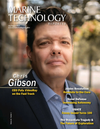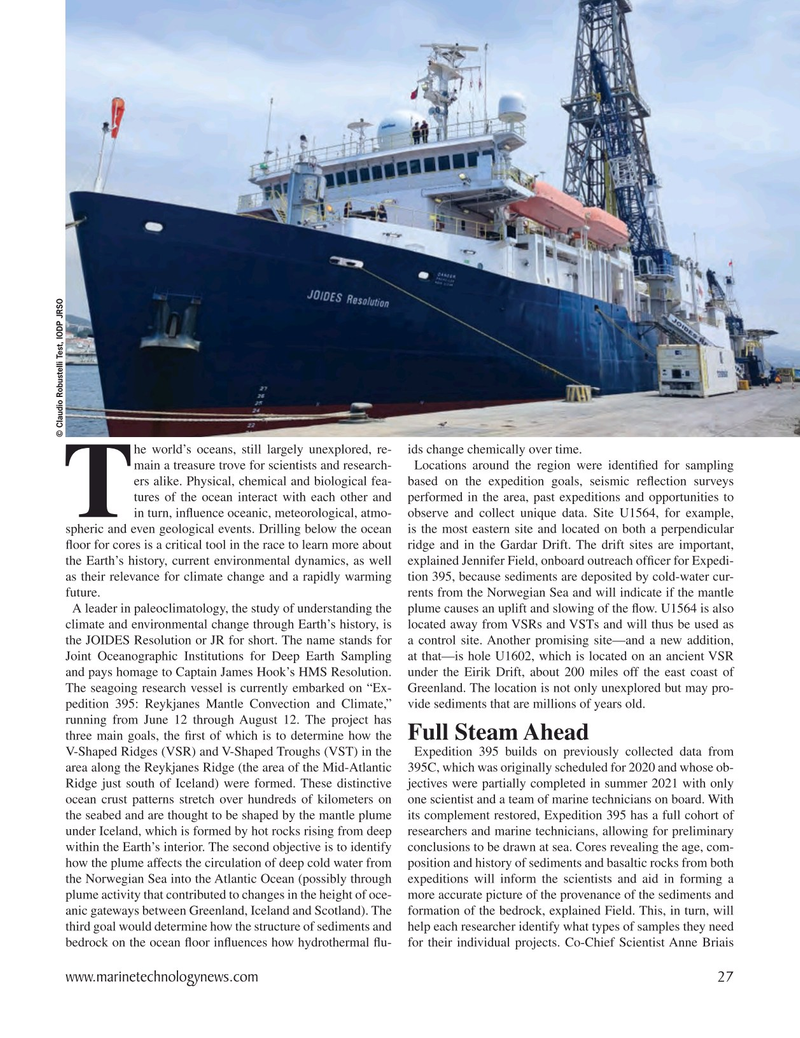
Page 27: of Marine Technology Magazine (July 2023)
Read this page in Pdf, Flash or Html5 edition of July 2023 Marine Technology Magazine
© Claudio Robustelli Test, IODP JRSO he world’s oceans, still largely unexplored, re- ids change chemically over time. main a treasure trove for scientists and research- Locations around the region were identi? ed for sampling ers alike. Physical, chemical and biological fea- based on the expedition goals, seismic re? ection surveys tures of the ocean interact with each other and performed in the area, past expeditions and opportunities to
Tin turn, in? uence oceanic, meteorological, atmo- observe and collect unique data. Site U1564, for example, spheric and even geological events. Drilling below the ocean is the most eastern site and located on both a perpendicular ? oor for cores is a critical tool in the race to learn more about ridge and in the Gardar Drift. The drift sites are important, the Earth’s history, current environmental dynamics, as well explained Jennifer Field, onboard outreach of? cer for Expedi- as their relevance for climate change and a rapidly warming tion 395, because sediments are deposited by cold-water cur- future. rents from the Norwegian Sea and will indicate if the mantle
A leader in paleoclimatology, the study of understanding the plume causes an uplift and slowing of the ? ow. U1564 is also climate and environmental change through Earth’s history, is located away from VSRs and VSTs and will thus be used as the JOIDES Resolution or JR for short. The name stands for a control site. Another promising site—and a new addition,
Joint Oceanographic Institutions for Deep Earth Sampling at that—is hole U1602, which is located on an ancient VSR and pays homage to Captain James Hook’s HMS Resolution. under the Eirik Drift, about 200 miles off the east coast of
The seagoing research vessel is currently embarked on “Ex- Greenland. The location is not only unexplored but may pro- pedition 395: Reykjanes Mantle Convection and Climate,” vide sediments that are millions of years old. running from June 12 through August 12. The project has three main goals, the ? rst of which is to determine how the Full Steam Ahead
V-Shaped Ridges (VSR) and V-Shaped Troughs (VST) in the Expedition 395 builds on previously collected data from area along the Reykjanes Ridge (the area of the Mid-Atlantic 395C, which was originally scheduled for 2020 and whose ob-
Ridge just south of Iceland) were formed. These distinctive jectives were partially completed in summer 2021 with only ocean crust patterns stretch over hundreds of kilometers on one scientist and a team of marine technicians on board. With the seabed and are thought to be shaped by the mantle plume its complement restored, Expedition 395 has a full cohort of under Iceland, which is formed by hot rocks rising from deep researchers and marine technicians, allowing for preliminary within the Earth’s interior. The second objective is to identify conclusions to be drawn at sea. Cores revealing the age, com- how the plume affects the circulation of deep cold water from position and history of sediments and basaltic rocks from both the Norwegian Sea into the Atlantic Ocean (possibly through expeditions will inform the scientists and aid in forming a plume activity that contributed to changes in the height of oce- more accurate picture of the provenance of the sediments and anic gateways between Greenland, Iceland and Scotland). The formation of the bedrock, explained Field. This, in turn, will third goal would determine how the structure of sediments and help each researcher identify what types of samples they need bedrock on the ocean ? oor in? uences how hydrothermal ? u- for their individual projects. Co-Chief Scientist Anne Briais www.marinetechnologynews.com 27
MTR #5 (18-33).indd 27 7/21/2023 9:06:24 AM

 26
26

 28
28
